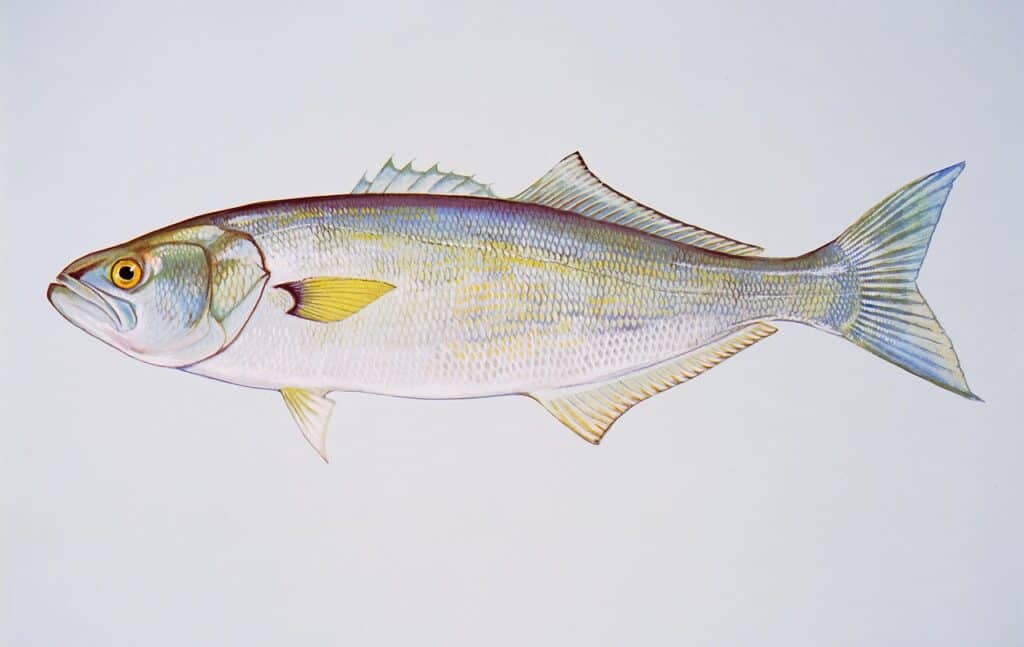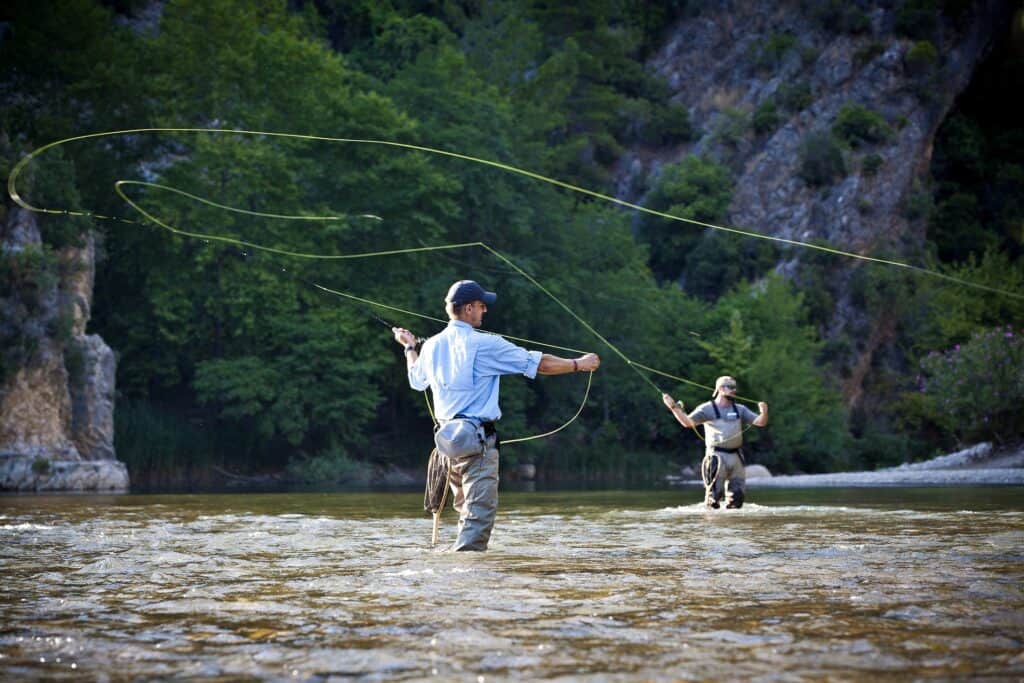
Stripping in a large, flashy fly as the waves crash around you will quickly progress from serene to tiring. Large streamers cast on heavy, long rods make for great pictures in magazines but strained forearms in reality.
For a moment, you will wonder why you even bothered to try and catch a bluefish on a fly. Jerking the streamer to let it flutter and flash in the surf requires a level of endurance that few fishermen possess. What once seemed like a challenge now seems like an unforgiving chore.
Then one strikes.
The rod begins to fold up, and the reel whines. You are on your back in a flash of a second, and the fight of a lifetime rest in the palms of your hands. Pushing your palm against the reel, you attempt to aid the drag as the bluefish explodes in a dazzling jump worthy of a Hemingway novel.
In that moment, you remember why you are there. You feel the joy of your childhood course through your veins as the fish kicks its tail back and forth before disappearing into the deep blue that gave you the experience.
This is the excitement of a Bluefish on a fly.
All About Bluefish
Bluefish are a classic gamefish that anglers seek all over the east coast. Given their proclivity toward extremely fierce fights and their love for shallow water, it is easy to see why. More than one angler has fallen in love with fishing after catching their first hard-fighting bluefish.
Their torpedo-like body with a forked tail will often grow up to three feet in length but will not exceed 20 lbs in weight. This allows them to be both picture worthy but manageable on lighter tackle and from shore.
Additionally, many anglers chase bluefish for their exquisite taste and the sheer joy of catching them. While many fish can be wild fun to catch, fight, and land, they are lackluster on your dinner plate. Due to their high protein diet and extremely active nature, bluefish produce some of the finest food you can eat when prepared correctly.
Where to Find Bluefish
Anywhere on the east coast of the United States will hold bluefish. They are commonly caught from the Florida Keys to the most northern shores of Maine. This aspect makes them a fun fish to catch as there is a large body of anglers to exchange ideas and share experiences with.
Additionally, they are easily accessed due to their desire to stay in shallow waters. Provided they have some structure to orient themselves to, such as drop-offs, sand bars, or rocks, bluefish will prey on passing schools of baitfish for them to ambush.
Finding them can be difficult initially, but they will generally stay in the same areas over long periods. This makes them a reliable fish to catch on an afternoon when you are looking for something fun to do. Water that is around the mid-60s in temperature that has strong currents to concentrate baitfish is the ideal place to find them.
Packing the Tacklebox

Bluefish are aggressive, high-energy, and fierce-fighting fish that will challenge your ability as a fisherman at every turn. Ensuring you have the correct equipment and tackle is crucial to successfully landing bluefish.
Rods—When catching bluefish, you will want to tailor your rod choice based on the situation. A 9-foot, 9wt will suffice for catching them most of the time. However, special circumstances could lead to a deviation from the norm. Needing to cast longer distances will demand a longer rod, as will larger fish force you into a heavier weight. Yet these situations are rare, and a 9-foot, 9wt should do the trick in nearly all situations.
Reels— Bluefish are popular among flyfishermen because of the incredible fights they can produce. However, to hold on to one long enough to land it, you will need a reel that has a solid drag. Given their tendency to jump and run, you will also want the reel to have a fairly decent capacity. Many reels can fit this large capacity, quality, drag description, and budget will often be the determining factor in which one is ultimately used. No matter what reel is chosen, ensure it is meant for salt water, or it will seize up long before its lifespan is over.
Leaders—The leader may be the most crucial piece of your entire bluefish on a fly setup. Due to their keen eyesight, love for clear water, and razor-sharp teeth, selecting the correct leader is more than important. You will need to use a 30-40 lb test leader to compensate for their sharp, large teeth. This will give you the abrasion resistance needed for prolonged fights. Use an exceptionally long leader to keep them from spooking at the sight of your fly line. Twelve feet should be the go-to length for your bluefish leaders. Change your leaders frequently to avoid creating weak spots resulting in a lost fish.
Flies— Bluefish are your classic saltwater predator that loves to chase baitfish daily. Therefore, tailoring your fly choice to that end is crucial. Streamers made of high-quality material that are six inches long and are jerked frequently will provide the action needed to get a bluefish’s attention. Use blue, white, and silver to capitalize on clear water with a lot of light penetration to produce an eye-catching flash. Great patterns for this are the Clouser Minnows and Surf Candies.
Hooks— Typically, a 1/0 hook will suffice for bluefish. However, there are situations where the population you are engaging is larger. If you frequently lose fish but are not breaking your line, upgrade your hook size to a 3/0. This will require you to keep a large collection of bluefish-oriented flies ready so you can tailor your presentation to the situation.
Tips for Catching Bluefish on a Fly
Bigger is Better- Bluefish are audacious creatures. They will jump on anything they believe they can take a bite out of. Therefore, give them a target that they will consider worth their effort. You should be presenting the biggest fly you and your equipment can muster.
Look For Sign- You will know when bluefish work in the area. You will often see them outright in the surf as they chase baitfish around. However, many times you will see the baitfish boil the surface of the water or birds diving into them. Paying attention to the signs of bluefish working in the area will pay dividends.
Strip Quickly-Bluefish are instinct-driven predators. Therefore, your best bet is to play to those instincts. A twitchy, jerky, fast-moving fly will best imitate the erratic nature of the baitfish they love to feed on. Therefore, strip in your fly quickly, allow for prolonged pauses, and change the direction of the fly frequently. Doing this will imitate the baitfish the bluefish are feeding on. As a result, you will have more strikes more frequently.
Catching Bluefish with Scout Boats

Bluefish love to chase baitfish every hour of the day. Your job as a fisherman is to figure out where those baitfish are and meet the bluefish there. That means working exceptionally shallow areas, jetties, and other areas rich in food for the bluefish’s prey.
The 177 Sport from Scout Boats is the ideal shallow-water access vessel. You don’t need a lot of complex amenities for long days out on the water to successfully catch bluefish on a fly. Instead, you need access to secluded areas that hold the baitfish they are chasing.

